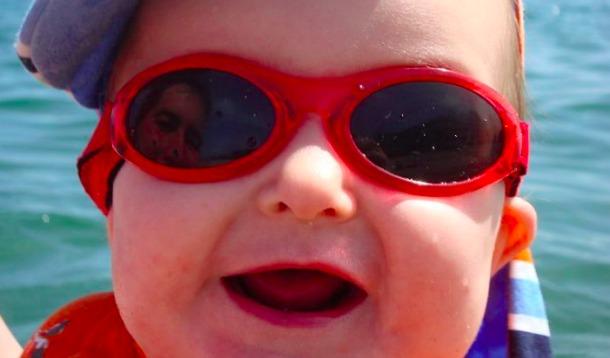
We all know the dangers of soaking up a little too much sun: sunburns, premature aging, and most frighteningly, skin cancer. Most parents I know, myself included, reach for sunny-day basics like hats, sunscreen, and lightweight clothes to help cover our children’s skin from UV rays but we often forget one really important thing: our children’s eyes.
Just like the painful sunburns we experience on our skin, UV light can cause temporary pain and discomfort when too much has been absorbed by the eyes. And, just like those sunburns on our skin, the absorption of UV light - which is cumulative - can cause serious and lasting eye damage, including diseases like cataracts, macular degeneration, and even melanomas. Yikes! And a sunburn on your cornea is exactly as fun as it sounds and feels rather like having sandpaper in your eye. Not fun...or safe.
Our little one’s eyes are more vulnerable to UV damage because the crystalline lens in children’s eyes is actually less capable of filtering UV rays than an adult’s eyes, and since most kids spend more time outdoors than adults our little ones receive about three times more UV ray dosage than we do each year. The World Health Organization estimates that 50% of lifetime UV exposure happens by age 18.
The good news is that we can protect our children’s eyes in much the same way we protect their skin!
Whether your child is big or small, wearing sunglasses with 100% UV protection is crucial to overall eye health. And with practice, wearing sunglasses will become second-nature.

Now, before you rush to the store and grab the first pair of adorable kiddo shades you see, be sure to consider these five things:
Whether a prescription lens or not, sunglasses should be 100% UV blocking - meaning they block both UVA and UVB rays - and are close-fitting with a wraparound style to help keep light out. Don’t let a dark lens fool you either - the intensity of the shade does not equal better protection. Look for the 100% UV Blocking sticker on the lens or tag.
There's no need to visit store after store to find the right sunglasses. You can find great 100% UV-blocking sunglasses in an assortment of styles at most Doctor of Optometry offices. They can also make specific recommendations to ensure your eyes are well-protected and fit you for your perfect pair. Talk about convenience!
Kids are far more likely to fall or run into something than the average adult (playground tumbles, am I right?), so finding a tough polycarbonate lens is important to avoid accidental damage from a broken lens. Polycarbonate lenses are up to 10 times more impact-resistant than standard plastic lenses, not to mention lighter than glass or standard plastic lenses, meaning our littles will be more comfortable. Further: look for “unbreakable” or flexible frames.
Spring Hinges that extend beyond 90 degrees help to keep the fit of the frame snug, decreasing the likelihood that your child’s sunglasses fall off or get damaged while playing. For even better staying power, consider an elastic band (or sport strap) - especially helpful for the really little ones.
If your child wears corrective lenses, your Doctor of Optometry will be able to prescribe and guide you when purchasing prescription sunglasses or clip-ons. If you have a teen who wears corrective contact lenses, be sure to ask about UV-blocking contact lenses to further protect their eyes.
Sure, we’re all hyper-aware of UV rays when we’re baring it all on the beach, but the reality is that MORE UV rays enter our eyes during the winter, since snow reflects up to 95% of sunlight. Make sure you’re vigilant about sunglasses (and sunscreen) year-round - even on less than super sunny days.
All kids (and adults) should wear sunglasses with 100% UV protection in addition to hats, lightweight clothing and sunscreen. Further, if you can avoid being in direct sunlight during peak hours (between 10 am and 4 pm) that’s even better.
My son loves to wear his hat, but getting him onto the sunglasses train was a lot harder. By letting him pick out Mom (and DOO) approved, 100% UV-blocking sunglasses that he thinks are cool, I’ve made sunglasses feel less like a chore and more like an extension of his superhero, super-cool style.
Your Doctor of Optometry can make specific recommendations for you, and your child, to ensure that you’re protecting your peepers with well-fitting sunglasses and the appropriate prescription (if needed). In addition, a comprehensive eye exam can identify early onset of eye-health conditions related to UV exposure that may not have any apparent symptoms.
Now stop reading, “shade" up, and get outside!
Did you know 75% of vision loss is preventable? It’s time to open your eyes to maintaining healthy vision.
Take a few minutes to scan these articles that will teach you everything you need to know about eye health.


This post is brought to you by Doctors of Optometry Canada.
www.doctorsofoptometry.ca
Connect with the Doctors of Optometry Canada on Facebook: https://www.facebook.com/AskaDoctorofOptometry